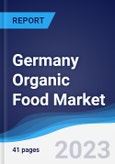Key Highlights
- Organic food includes produce that has been independently certified to have been grown free of chemicals. For the purposes of this report, eggs have been classified as part of the meat, fish and poultry segment. Market values are taken at retail selling price (RSP).
- The German organic food market had total revenues of $18.9 billion in 2022, representing a compound annual growth rate (CAGR) of 11.7% between 2017 and 2022.
- The meat, fish & poultry segment accounted for the market's largest proportion in 2022, with total revenues of $9.9 billion, equivalent to 52% of the market's overall value.
- According to the USDA, Germany and France remain the largest organic markets in the EU, representing more than 60% of its organic market.
Scope
- Save time carrying out entry-level research by identifying the size, growth, major segments, and leading players in the organic food market in Germany
- Use the Five Forces analysis to determine the competitive intensity and therefore attractiveness of the organic food market in Germany
- Leading company profiles reveal details of key organic food market players’ global operations and financial performance
- Add weight to presentations and pitches by understanding the future growth prospects of the Germany organic food market with five year forecasts
Reasons to Buy
- What was the size of the Germany organic food market by value in 2022?
- What will be the size of the Germany organic food market in 2027?
- What factors are affecting the strength of competition in the Germany organic food market?
- How has the market performed over the last five years?
- What are the main segments that make up Germany's organic food market?
Table of Contents
Companies Mentioned (Partial List)
A selection of companies mentioned in this report includes, but is not limited to:
- Aldi Einkauf GmbH & Co oHG
- REWE Group
- Edeka Zentrale AG & Co KG
- AlnaturA Produktions- und Handels GmbH








